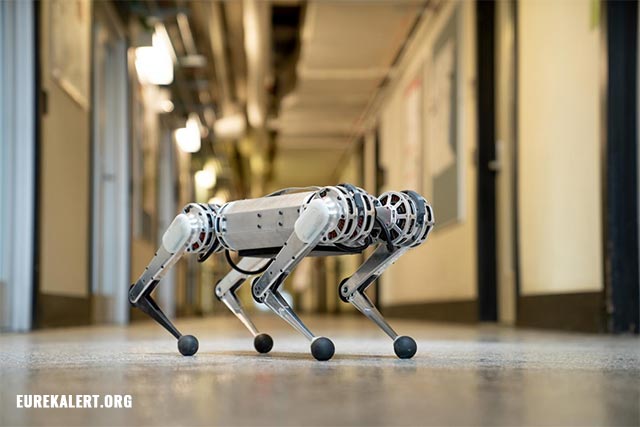Stanford researchers create dog-like robot that anyone can create and modify
12/14/2019 / By Michael Alexander

You’ve heard about adopting dogs from shelters, but have you heard about building one from scratch?
Members of the Stanford Student Robotics club’s Extreme Mobility team at Stanford University recently developed a four-legged robot that not only performs acrobatic tricks, but also traverses challenging terrain.
Dubbed “Stanford Doggo” by the team, the beagle-sized robot is the club’s answer to standard quadruped robots used in research today. But unlike those robots, Stanford Doggo was desgined as an open source robot that can be built and customized by others. In fact, the students who developed it have also made everything you need to build your own — comprehensive plans, code and a supply list — freely available online.
“We had seen these other quadruped robots used in research, but they weren’t something that you could bring into your own lab and use for your own projects,” Nathan Kau, a mechanical engineering major and the lead for Extreme Mobility, said in an interview. “We wanted Stanford Doggo to be this open source robot that you could build yourself on a relatively small budget.”
According to Extreme Mobility, while standard quadruped robots can cost tens or hundreds of thousands of dollars and require customized parts, the total cost of building Stanford Doggo — including manufacturing and shipping costs — is less than $3,000. The team also said that most of its components can be purchased online, so they hope that easy access to these resources will inspire others to develop innovative and meaningful spinoffs from their work.
Cheap, small but powerful
Despite its relatively cheap price tag, Extreme Mobility says people shouldn’t discount Stanford Doggo’s capabilities. While the robot’s first few steps resembled those of a toddler, Stanford Doggo soon learned to maintain a consistent gait, even when traversing difficult terrains. (Related: FREAKY: Boston Dynamics’ SpotMini robo-dogs can coordinate, navigate, open doors, climb stairs and even load the dishwasher.)
The key to its adaptability lies with its motors, which can sense external forces. These motors feed pertinent information to the robot’s legs, such as the amount of force and torque each leg needs to apply under certain conditions. Stanford Doggo’s motors can recompute at 8,000 times a second, and this allows it to maintain a desired trajectory and even rebound into proper form whenever it gets out of position.
Stanford Doggo’s motors, coupled with improvements in the design of its leg mechanism, are what allow it to perform better than more expensive robots. Stanford Doggo boasts greater torque than a similarly sized robot developed by the company Ghost Robotics. It even has a greater vertical jumping ability than the Cheetah 3 robot developed by a team from Massachusetts Institute of Technology.
According to Kau, he and his team pushed the limits of Stanford Doggo’s software to make it jump three-and-a-half feet off the ground.
“This was when we realized that the robot was, in some respects, higher performing than other quadruped robots used in research, even though it was really low cost,” Kau said.
A Stanford Doggo for everyone?
The Extreme Mobility team says their goal is to eventually see Stanford Doggo everywhere and in the hands of the masses.
“We’re hoping to provide a baseline system that anyone could build,” said Patrick Slade, a graduate student in aeronautics and astronautics and Extreme Mobility’s mentor.
“Say, for example, you wanted to work on search and rescue; you could outfit it with sensors and write code on top of ours that would let it climb rock piles or excavate through caves. Or maybe it’s picking up stuff with an arm or carrying a package,” explained Slade.
But despite Extreme Mobility’s plans for Stanford Doggo, its open source nature leaves it vulnerable to hacking and even possible weaponization ?— two scenarios that could easily be achieved. Just last year, researchers from Brown University successfully hacked into and took control of a robot called Herb2, which was developed and owned by a team from the University of Washington. They managed to do so by merely scanning for internet-connected robots as part of their Robot Operating System (ROS) Internet Mapping Project.
Researchers from Seattle-based cybersecurity firm IOActive also achieved a similar feat. Aside from successfully hacking into a number of popular home robots and turning them into surveillance devices, they also showed that even “friendly” humanoid home robots can be remotely controlled in ways that can harm humans.
But while technology hasn’t advanced to a point where robots pose a real threat to human safety, Stanford Doggo and other quadruped robots can be seen as promising technological marvels heralding a future where robots can work alongside humans.
Interested in all things tech and robotic? Head over to Robots.news for more stories.
Sources include:
Tagged Under: AI, artificial intelligence, breakthrough, future science, future tech, goodtech, innovation, inventions, machine learning, research, robot, robot dog, robotics, robots, science and technology, surveillance
RECENT NEWS & ARTICLES
COPYRIGHT © 2017 SCIENTIFIC NEWS




















